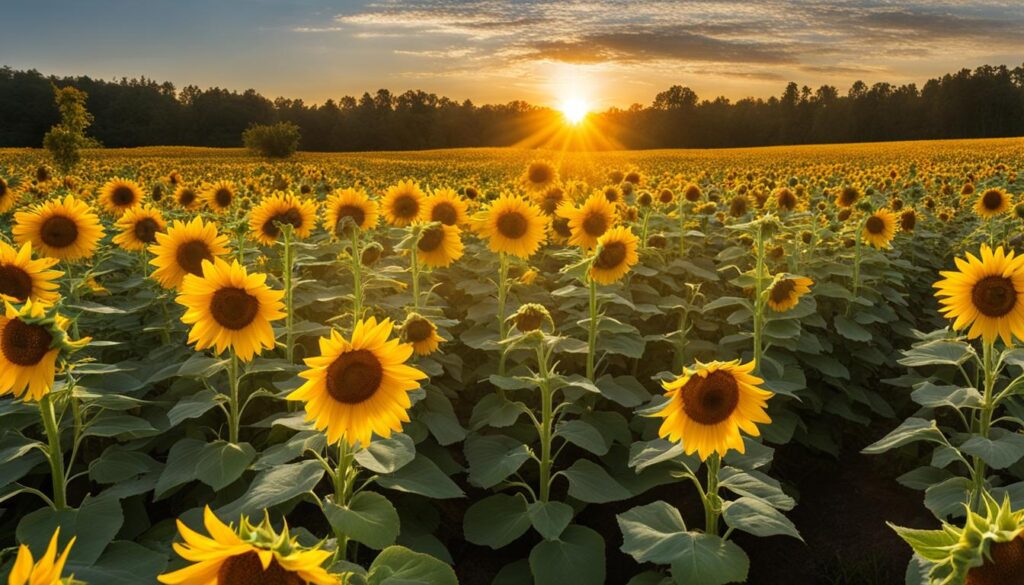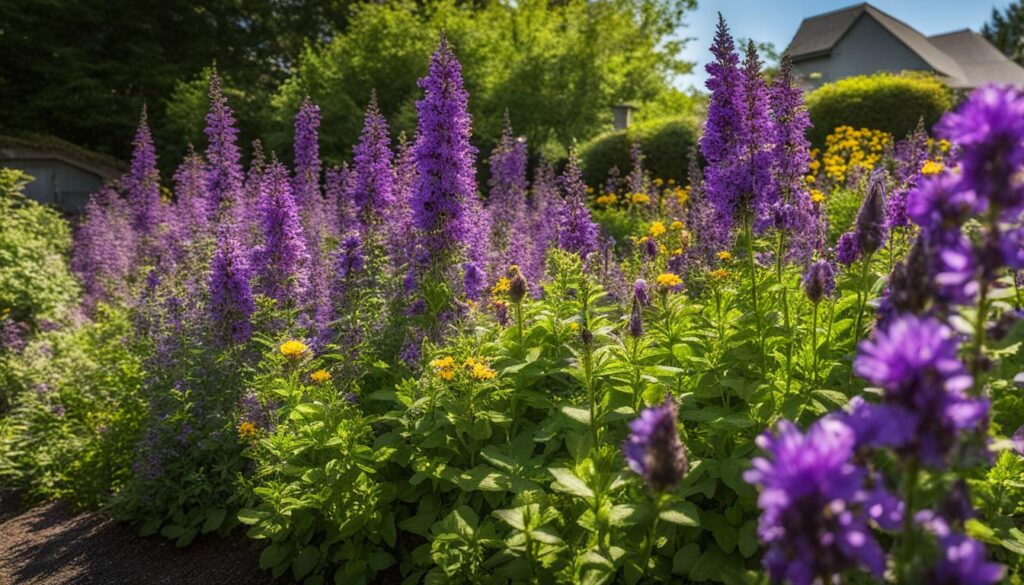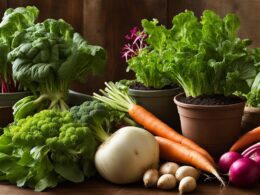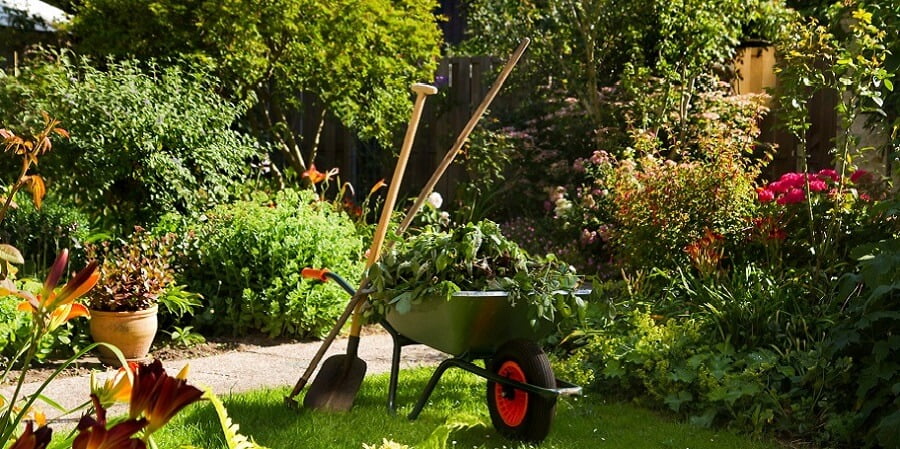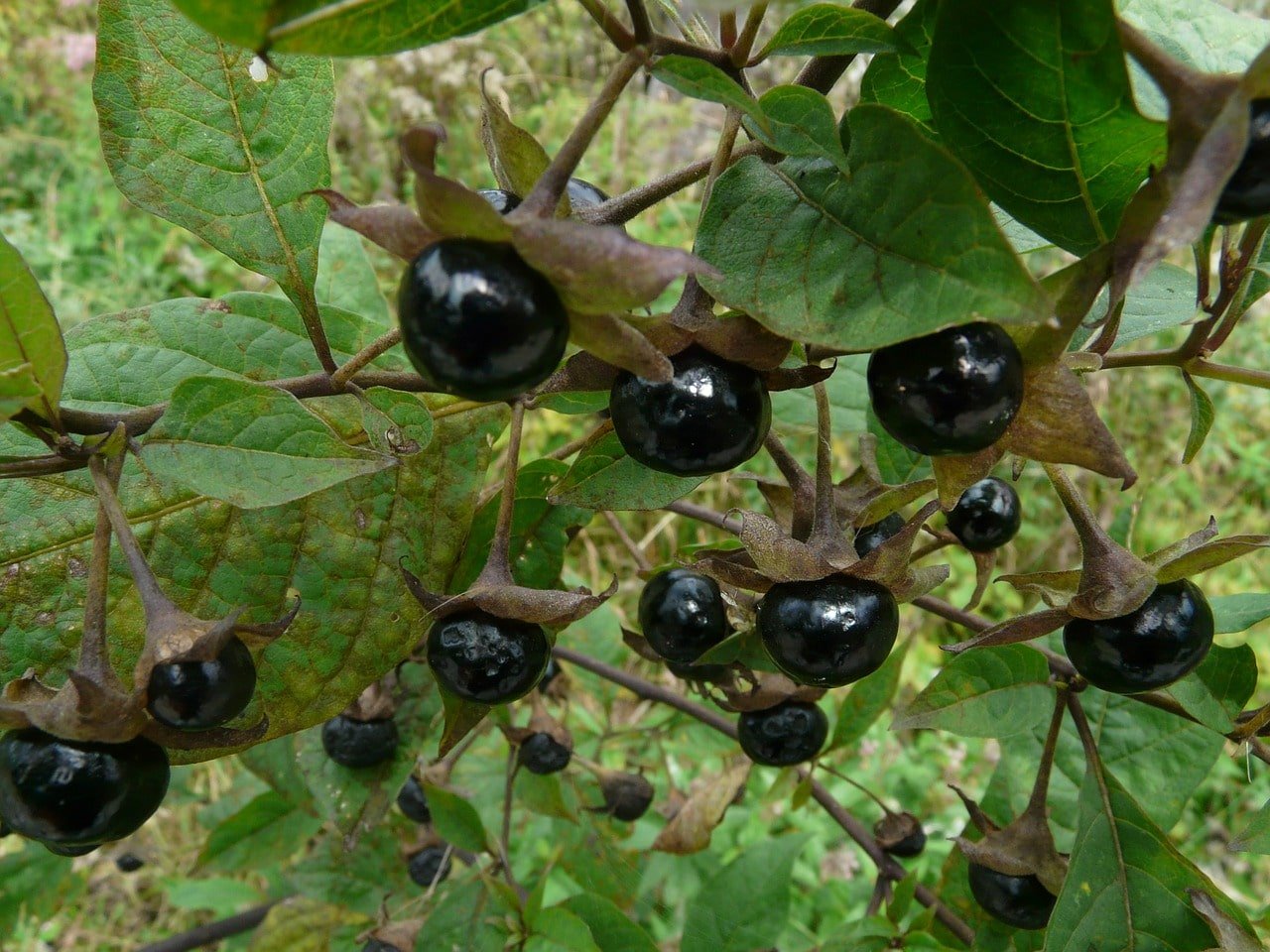Are you wondering if marigolds attract bees? In the world of gardening, attracting bees is essential for a thriving ecosystem. Bees play a crucial role in pollination, ensuring the growth and reproduction of plants. Understanding which flowers attract bees can help you create a garden that not only looks beautiful but also supports these important pollinators.
Key Takeaways:
- Marigolds, especially pot marigold and corn marigold, are known to attract bees.
- Other flowers that attract bees include goldenrod, bee balm, black-eyed Susan, borage, and California poppies.
- Factors such as the ultraviolet spectrum of colors and the pollination needs of different plants influence bee attraction.
- Choosing flowers like liatris, low-growing sunflowers, and phacelia can attract bees to your garden.
- Creating a diverse pollinator garden with a variety of bee-friendly flowers supports pollination and contributes to a healthy garden ecosystem.
Other Flowers That Attract Bees
Marigolds are not the only flowers that attract bees to your garden. There are several other varieties that bees find irresistible. Let’s explore some of them:
Bee Balm
Bee balm (Monarda) is a fragrant flower that bees are particularly fond of. Its vibrant blooms and aromatic foliage make it a favorite among both humans and bees. This perennial plant comes in various colors, including red, pink, and purple, and it attracts a wide range of bee species. Consider adding bee balm to your garden to provide a feast for these pollinators.
Black-eyed Susan
Black-eyed Susan (Rudbeckia hirta) is a native wildflower that bees simply cannot resist. With its bright yellow petals and dark centers, this daisy-like flower adds a splash of color to your garden while also attracting bees. Black-eyed Susan blooms from summer to fall, providing a reliable source of nectar and pollen for bees during their active season.
Goldenrod
Contrary to popular belief, goldenrod (Solidago) does not cause allergies; it actually attracts bees and other beneficial insects. This vibrant yellow flower blooms in late summer and early fall, coinciding with the time when bees are foraging for food to prepare for winter. Goldenrod provides abundant nectar and pollen, making it a valuable resource for bees.
Borage
Borage (Borago officinalis) is a beautiful blue flower that not only attracts bees but also benefits your garden. This herbaceous plant produces edible flowers that have a mild cucumber flavor and are often used in salads or as a garnish. Bees are attracted to borage for its nectar-rich blooms, making it an excellent addition to any bee-friendly garden.
California Poppies
California poppies (Eschscholzia californica) are bright, cheerful flowers that bees adore. With their vibrant orange, yellow, pink, or white blooms, these flowers provide a visual feast while also supplying bees with a source of nectar. California poppies are easy to grow and can add a splash of color to your garden while attracting bees.
By incorporating these flowers into your garden, you can create a bee-friendly environment that supports these important pollinators while adding beauty to your outdoor space.
Factors Influencing Bee Attraction to Flowers
When it comes to attracting bees, the colors of flowers play a significant role. Bees are especially drawn to flowers that fall within the ultraviolet spectrum, which includes colors that may appear ordinary to us but are intensely glowing to these pollinators. This is because bees have the ability to see ultraviolet light, allowing them to perceive colors and patterns that are invisible to humans. By understanding the ultraviolet spectrum, you can choose flowers that will be more appealing to bees and increase their presence in your garden.
While colorful flowers like marigolds initially catch the attention of bees, it’s important to consider the specific pollination needs of other plants. Some crop plants, such as tomatoes, corn, and peppers, are wind-pollinated and do not rely heavily on pollinators for successful fertilization. These plants produce enough pollen and have the proximity required for effective wind pollination. Additionally, certain flowering plants like radishes and onions, although they do attract bees, do not require pollination for their growth. In these cases, attracting bees with additional flowers may not be necessary.
To further illustrate the factors influencing bee attraction to flowers, here is a table showcasing the role of flower colors and the pollination needs of different crop plants:
| Flower Colors | Pollination Needs |
|---|---|
| Colors within the ultraviolet spectrum | Attractive to bees |
| Colors outside the ultraviolet spectrum | May be less appealing to bees |
| Tomatoes, corn, peppers | Wind-pollinated, less reliant on pollinators |
| Radishes, onions | Do not require pollination for growth |
By considering these factors and understanding the specific needs of your plants, you can make informed decisions about which flowers to attract bees to your garden. Whether it’s selecting flowers with colors that are highly visible to bees or focusing on other pollinator-friendly plants, creating a diverse garden will contribute to a healthy ecosystem and promote successful pollination.
Choosing Flowers to Attract Bees in Your Garden
If you want to attract bees to your garden, there are several flowers that you can consider planting. These flowers not only provide a beautiful display but also serve as a valuable food source for bees, helping to support their populations. Here are a few options that you can incorporate into your pollinator garden:
Liatris
Liatris, also known as blazing star or gayfeather, is a stunning perennial flower that bees are particularly drawn to. It features tall spikes of vibrant purple or white flowers that resemble bottle brushes. The unique shape and color of the flowers make them highly attractive to bees, enticing them to visit your garden.
Low-Growing Sunflower
A low-growing sunflower variety can be a great addition to your garden if you want to attract bees. These sunflowers, which typically stay under 4 feet in height, provide a source of nectar and pollen for bees while also adding a touch of brightness to your garden. They can be planted alongside your main summer crops to provide extra food for bees and deter pests.
Phacelia
Phacelia is an annual flower that blooms early in the season, making it an excellent choice for attracting bees during the spring months. Its delicate lavender-blue flowers are highly attractive to bees, and the plant is known to produce an abundance of nectar. Adding phacelia to your garden is a sure way to create a buzz among the bees.
By incorporating these flowers into your pollinator garden, you can create a diverse and vibrant ecosystem that will attract bees throughout the growing season. Remember to choose flowers with different bloom times and heights to ensure a continuous supply of nectar and pollen for your buzzing friends. Happy gardening!
Do Marigolds Attract Bees to Help with Pollination?
Yes, marigolds can act as pollinators by attracting bees to facilitate the pollination process. Bees are drawn to the bright, vibrant color and unique scent of marigolds, making them an essential part of a garden’s ecosystem. Using marigolds as pollinators can promote healthy plant growth and increase crop yield.
Do Marigolds Attract Bees? The Verdict.
Marigolds, including pot marigold and corn marigold, have been proven to be attractive to bees and play a crucial role in pollination. These vibrant flowers offer valuable nectar and pollen rewards, making them a valuable resource for our buzzing friends. However, the level of attractiveness may vary depending on the specific marigold species and its characteristics.
While marigolds can be beneficial for attracting bees to your garden, it’s important to consider the pollination needs of other crops and flowering plants as well. Different plants have different requirements when it comes to pollination, and understanding these needs can help you create a garden ecosystem that promotes healthy pollination.
By incorporating a variety of bee-friendly flowers into your garden, you can contribute to the overall health of the garden ecosystem. Creating a diverse pollinator garden with flowers that bloom at different times and heights ensures a continuous supply of nectar and pollen throughout the growing season, benefiting not only bees but also other pollinators.
In conclusion, marigolds have been shown to attract bees and provide nectar and pollen rewards. However, it’s important to have a holistic approach to creating a garden ecosystem that supports the pollination needs of various plants. By understanding the role of different flowers in supporting bee populations and promoting pollination, you can contribute to a thriving garden and a healthier environment for all.
FAQ
Do marigolds attract bees?
Yes, marigolds have long been thought to attract bees. However, the extent of their appeal depends on the specific species of marigold.
Which species of marigold are particularly attractive to bees?
Pot marigold (Calendula officinalis) and corn marigold (Glebionis segetum) have been found to be particularly attractive to bees.
What other flowers attract bees?
Other flowers that attract bees include goldenrod, bee balm, black-eyed Susan, borage, and California poppies.
What factors influence bee attraction to flowers?
The attractiveness of flowers to bees depends on factors such as the ultraviolet spectrum of colors that insects can see, as well as the specific pollination needs of different plants.
How can I choose flowers to attract bees in my garden?
Consider planting flowers like liatris, low-growing sunflowers, and phacelia to attract bees to your garden. Building a diverse pollinator garden with a variety of flowers can ensure a continuous supply of nectar and pollen for bees throughout the growing season.
Do marigolds play a significant role in bee attraction and pollination?
Marigolds, particularly pot marigold and corn marigold, have been shown to attract bees and provide nectar and pollen rewards for these important pollinators. However, it is also important to consider the specific pollination needs of other crops and flowering plants in your garden ecosystem.






